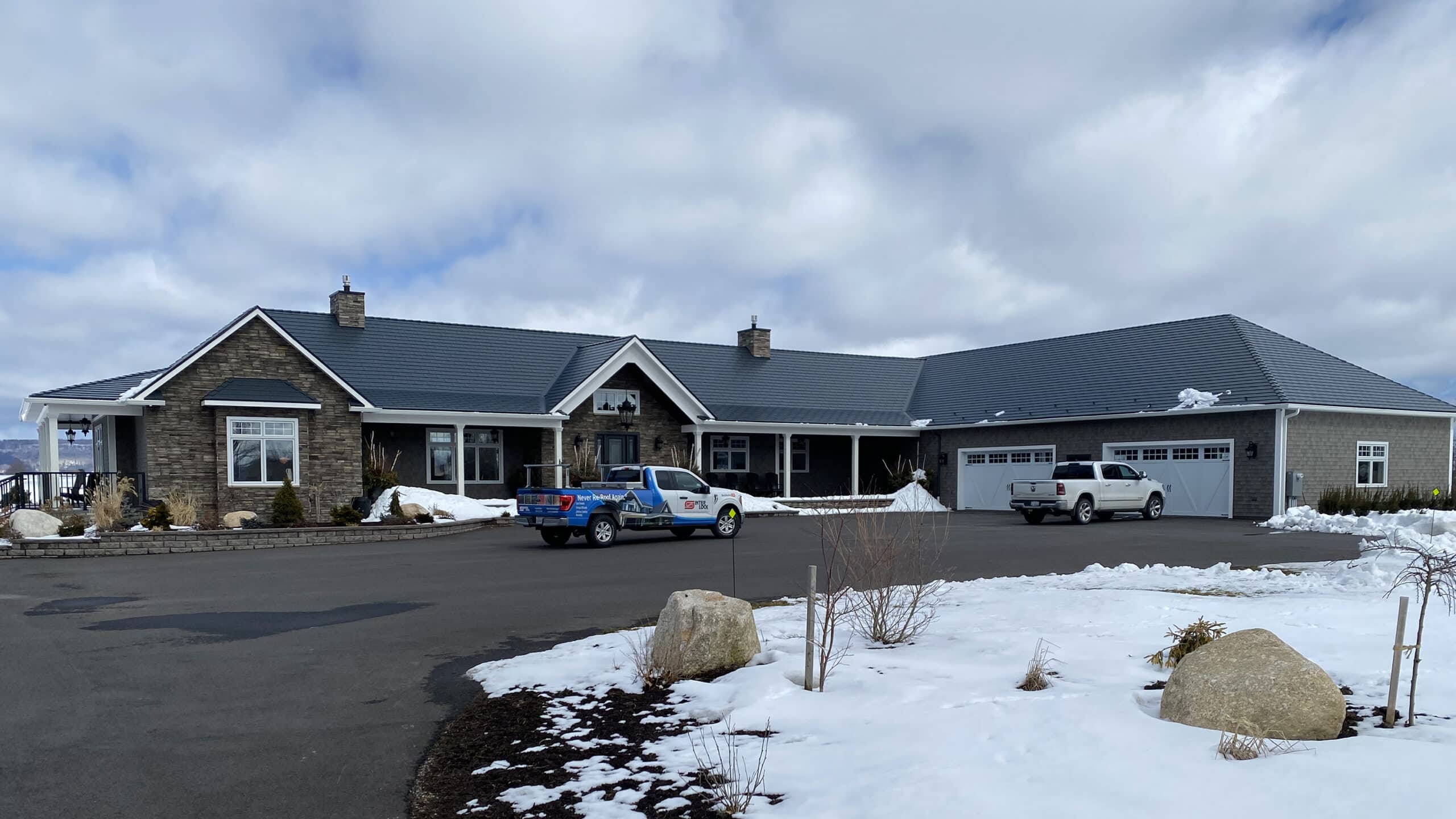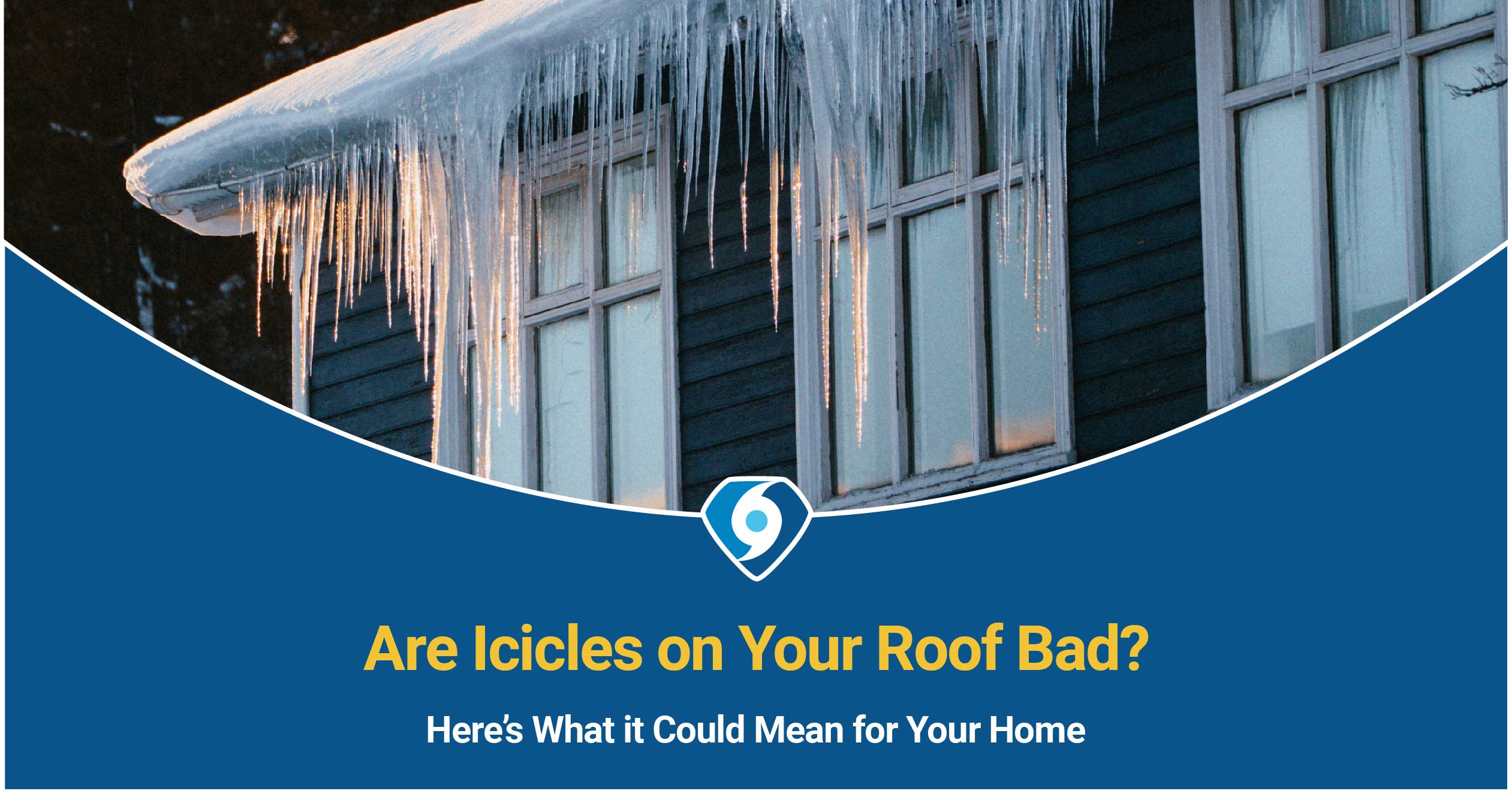To prevent ice dams, ensure proper attic insulation and ventilation. Regularly clear your roof of snow buildup after storms.
Ice dams on roofs can cause significant damage to both the structure of your home and its interior. These ridges of ice form at the edge of a roof and prevent melting snow from draining off. The resulting water can then leak into your home, leading to costly repairs.
Homeowners should prioritize preventing the formation of ice dams through effective insulation, adequate ventilation, and snow removal. A well-insulated attic keeps heat from escaping and melting the snow unevenly on the roof. Good ventilation allows the heat to dissipate before it melts the snow. Taking these steps, along with removing excess snow, can mitigate the formation of ice dams and preserve the integrity of your roofing system. Engaging in routine roof maintenance, especially after heavy snowfall, is crucial to managing ice dam related risks.
Understanding Ice Dams On Roofs
As winter’s grip tightens, homeowners often face the problematic phenomenon of ice dams. These icy impediments not only detract from your home’s aesthetic charm but can also spell disaster for its structural integrity. In this segment, we’ll delve into what exactly ice dams are, how they come into being, and the sort of havoc they can wreak on a residence.
Definition And Formation Process
An ice dam is an accumulation of ice that forms at the edge of a roof and prevents melting snow from draining off. The crux of the problem lies within the differences in roof temperature. As heat rises from inside your home, it warms the center of your roof, leading to the melting of snow. This meltwater trickles towards the colder roof edge and gutters, refreezing into an ice dam.
The steps in the formation of an ice dam typically involve:
- Heat Accumulation: Heat collects in the attic and warms the roof but not the eaves.
- Snow Melting: Snow on the warmer roof melts and flows to the cooler edge.
- Ice Formation: Water reaches the cold eaves and gutters and refreezes.
- Dam Growth: As this process repeats, the ice dam grows, trapping more snowmelt.
The Potential Damage To Homes
Unfortunately, ice dams are more than just a seasonal nuisance. They pose significant risks to your home. Key concerns include:
- Water Intrusion: Trapped water can seep under shingles, leading to leaks.
- Insulation Damage: Moisture entering the attic can degrade insulation, reducing its effectiveness.
- Mold and Mildew: Prolonged dampness from leaks paves the way for mold and mildew growth.
- Structural Damage: Excessive water can cause wood rot and overall structural compromise.
- Gutter Damage: The weight of ice can strain and damage gutters and downspouts.
Regular inspections, proper insulation, and swift action at the first sign of ice dam formation will significantly reduce the potential damage to your home during the winter season.
Tips For Preventing Ice Dams
Preventing ice dams from forming on your roof is crucial for maintaining the integrity and longevity of your home. Ice dams can cause significant damage, but with the right measures in place, you can significantly reduce the risk of their formation. Proper roof maintenance, insulation, and sealing strategies play a pivotal role in combating these icy build-ups. Here are some effective strategies to keep your home safe and dry throughout even the harshest winter.
Regular roof inspections and maintenanceRegular Roof Inspections And Maintenance
A well-maintained roof is the first defense against ice dams. It’s essential to conduct regular inspections especially before and after the winter season.
- Check for signs of wear and tear such as damaged shingles or water stains.
- Ensure that gutters and downspouts are clean to facilitate proper drainage.
- Trim branches hanging over the roof to prevent accumulation of debris and damage from broken limbs.
- Arrange for a professional evaluation periodically to catch potential issues early on.
Improving Attic Insulation And Ventilation
Proper attic insulation and ventilation are key in maintaining an even roof temperature. This helps in preventing the freezing and thawing cycle that contributes to ice dam formation.
- Ensure that insulation levels meet recommended R-values for your region.
- Install baffles at the eaves to maintain necessary air flow.
- Consider an attic air seal, which prevents warm air from entering the attic from the living spaces below.
- Inspect and improve ventilation points, like soffit, ridge, and gable vents.
Sealing Gaps To Prevent Heat Transfer
Transfer of heat from your home to your attic can create an ideal environment for ice dams to form. By sealing gaps and leakage points, you can reduce this risk.
| Area to Seal | Recommended Action |
|---|---|
| Attic floor | Use caulk or foam to seal gaps around pipes, wires, and ducts. |
| Light fixtures | Upgrade to sealed, IC-rated fixtures or seal existing fixtures with appropriate materials. |
| Chimneys and flues | Apply metal flashing and high-temperature caulk to properly seal these features. |
| Other leak-prone areas | Inspect and seal any additional penetration points commonly found in attic spaces. |
Remember, tackling these tasks can not only prevent ice dams but also enhance the energy efficiency of your home, leading to lower heating costs.
Dealing With Existing Ice Dams
An ice dam on your roof is more than a winter nuisance; it’s a threat to your home’s integrity. Recognizing this icy build-up is crucial, but knowing how to tackle the existing dams safely can save you from potential damage and costly repairs. Immediate action can prevent water from seeping under shingles, compromising insulation, and causing indoor havoc. Let’s dive into effective techniques for removing ice dams, the right tools for the job, and when it’s time to call the professionals.
Safe Ice Dam Removal Techniques
Removing ice dams quickly is key to preventing significant damage. Here are tried-and-true methods:
- Calcium Chloride Ice Melter: Use calcium chloride to melt the ice. Avoid rock salt or sodium chloride, which can damage your roof.
- Apply Heat Tape: Only if ice dams are a recurring issue, install heat tape in a zigzag pattern along the roof edge before winter arrives.
- Roof Rakes: Use these after each snowfall to prevent ice dam formation, being careful not to damage your shingles.
Note: Never attempt to chip away ice as this may harm your roof.
Tools And Equipment For Diy Removal
For DIY enthusiasts, the right tools make all the difference:
- Roof Rake: An extendable rake for safely scraping snow off your roof.
- Caulk Gun with Calcium Chloride Tubes: Useful for applying ice melt directly to the ice dam.
- Ladder: A stable ladder, properly anchored, is crucial for any work on your roof.
- Safety Gear: Always include a helmet, gloves, and anti-slip boots.
Ensure you have a solid plan and take necessary precautions to avoid injury or roof damage.
When To Hire A Professional
While some ice dams may be within the capacity of seasoned DIYers, many situations call for professional intervention. Consider hiring a pro if:
| Condition | Recommendation |
|---|---|
| High or Steep Roof | Avoid dangerous falls; professionals have the proper safety equipment. |
| Large Ice Dams | Professionals can remove these efficiently, minimizing potential damage. |
| Recurring Dams | Pros can assess underlying problems and suggest long-term solutions. |
Seek experts who specialize in ice dam removal for safe and effective service.
Handling Ice Dam Damage
Suffering from the aftermath of an ice dam can be as chilling as winter itself. Ice dams—a ridge of ice that forms at the edge of a roof, preventing melting snow from draining—can cause significant damage to your home. Acting promptly and effectively is crucial in preventing further damage and maintaining the integrity of your roof. In this section, we’ll explore how to identify damage, differentiate between short-term and long-term solutions, and navigate insurance claims and repairs after an ice dam takes a toll on your roof.
Identifying Damage From Ice Dams
Detection is the first step in addressing any roof damage. Look for common signs such as:
- Water stains on ceilings or walls indicating leakage.
- Peeling paint or damaged plaster beneath the roof overhang.
- Sagging or discolored soffits and gutters.
- Ice or water backup under shingles or behind fascia boards.
- Mold or mildew in the attic or on exterior walls.
Quick identification can lead to prompt action and mitigate extensive repair costs.
Short-term Versus Long-term Fixes
When dealing with ice dam damage, distinguishing between short-term and long-term strategies is essential:
| Short-Term Fixes | Long-Term Solutions |
|---|---|
|
|
While short-term fixes are immediate, long-term solutions can prevent future occurrences of ice dams.
Navigating Insurance Claims And Repairs
Initiating insurance claims can be daunting, yet it’s critical to ensure coverage for damages caused by ice dams. Ensure the following steps for a smooth process:
- Document the damage: Take clear photos and videos to provide evidence for your claim.
- Review your policy: Understand your coverage limitations and deductibles.
- Contact your insurance: File your claim promptly and provide all necessary documentation.
- Get professional assessments: Obtain detailed repair estimates from licensed contractors.
Successful navigation of insurance claims can lead to comprehensive repairs and restorations, without undue out-of-pocket expenses.
Ice Dam Prevention Strategies
Preventing ice dams from forming on your roof is crucial for protecting your home from water damage during the colder months. Effective strategies involve managing heat loss, improving ventilation, and enhancing the water-shedding capability of your roof. Let’s explore some practical solutions to stop these icy blockades before they can cause havoc.
Installing Heated Cables And Roof Components
Heated cables are a proactive approach to prevent ice dam formation. By running these cables along the roof’s edge, you create a heated pathway that ensures snowmelt drains off the roof, rather than refreezing and forming an ice dam.
- Choose self-regulating heat cables to conserve energy and prevent overheating.
- Install cables in a zigzag pattern along the roof edge where ice dams frequently occur.
- Ensure cables are attached to your roof using clips or brackets specifically designed for this purpose.
When integrating heat cables, consider complementing your system with improved insulation and ventilation to amplify the benefits.
Landscape And Design Considerations
Landscaping and home design play significant roles in ice dam prevention. Thoughtful planning can minimize risk factors contributing to ice dam buildup.
| Design Feature | Ice Dam Prevention Benefit |
|---|---|
| Strategic Tree Placement | Reduces snow accumulation on the roof by providing shade. |
| Ridge and Soffit Vents | Improves attic ventilation, reducing the chances of snow melting and refreezing on roof edges. |
| Roof Material and Color | Dark colors absorb more heat, aiding in the melting of snow, while certain materials provide slick surfaces that discourage ice formation. |
Ongoing Maintenance And Monitoring Plans
Regular maintenance and monitoring form the cornerstone of a robust ice dam prevention program. Setting up a maintenance schedule ensures that potential problems are identified and addressed before they become serious.
- Clean gutters and downspouts before the winter season to enable proper drainage.
- Inspect and replace damaged roof shingles and flashing to prevent water seepage.
- Arrange for professional roof inspections, particularly after heavy snowfall events, to identify areas at risk of ice dam formation.
Consistent monitoring, particularly through temperature changes, helps homeowners act swiftly in mitigating the risks of ice dams.

Credit: www.interlockroofing.com
Frequently Asked Questions On Tips For Preventing And Handling Ice Dams On Roofs
What Causes Ice Dams On Roofs?
Ice dams occur when heat escapes from a warm attic, melting snow on the roof. This meltwater refreezes at the colder roof’s edge, forming a dam. Proper attic insulation and ventilation can help prevent this cycle.
How Can Ice Dams Damage My Home?
Ice dams can lead to water leaks in your home. As ice accumulates, it can lift shingles, allowing water to seep underneath. This can cause damage to walls, ceilings, insulation, and the overall structure.
Are There Quick Fixes For Ice Dams?
Quick fixes for ice dams include using roof rakes to remove snow and applying calcium chloride ice melt. These are temporary solutions that can help mitigate dam formation and prevent water intrusion.
Can Gutter Guards Prevent Ice Dams?
Gutter guards alone do not prevent ice dams. They can reduce debris buildup, ensuring better water flow. However, proper attic insulation and ventilation are key to preventing ice dams.
Conclusion
As winter wanes, taking proactive steps to prevent ice dams is crucial. Implementing the tips shared here can protect your roof from costly damage. Regular maintenance and timely interventions are your best defense against these icy invaders. Don’t hesitate to consult professionals for safe, reliable solutions.
Stay vigilant and keep those dams at bay for a secure, dry home all season long.

